US Coast Guard Cutter Healy, Scientists Deploy Ice Stations
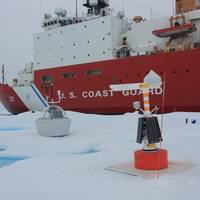
U.S. Coast Guard Cutter Healy (WAGB 20) crew and embarked researchers ventured onto a floe of multi-year ice for the first of three multi-instrument ice stations in the Arctic Ocean Basin late July and early August.As the Healy carefully approached and maintained position alongside an ice floe above 77 degrees north, the crew and a team of scientists, working in cooperation with the Office of Naval Research, (ONR) offloaded a diverse collection of equipment on to the floe carefully…
The Value of Friends in “High-Latitude” Places
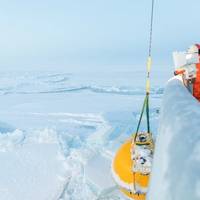
Who do you call when you need a job done on short notice, in total darkness, under 100-percent ice cover, thousands of meters at the bottom of the sea? In the case of the U.S. Office of Naval Research (ONR), you call your friends in Norway.That is exactly what the Chief of Naval Research Rear Admiral Lorin C. Selby did when he enlisted the help of the Norwegian Coast Guard icebreaker and offshore patrol vessel, the CGV Svalbard, to retrieve oceanographic moorings containing irreplaceable data.
Shrinking Arctic Sea Ice Raises Security Concerns
Shrinking ice cover is making the Arctic more accessible to various countries, commercial entities and researchers, among others."While Arctic sea ice continues to shrink, human activity in the region is only growing. Ice extent, which is monitored by the U.S. National Ice Center (USNIC), often determines what types of activities are pursued in the region," says NOAA National Environmental Satellite, Data, and Information Service (NESDIS).This increased human activity in the Arctic has also led to more national security concerns from both a traditional and non-traditional point of view. For the U.S., national security in the Arctic is more than just shielding the nation from potential threats to the northern border.Instead, the nation is starting to look at Arctic security more broadly.
US Navy Buoys into the Arctic Ocean
The U.S National Ice Center (USNIC) in coordination with the Office of Naval Research, Office of the Oceanographer of the Navy, the Danish Joint Arctic Command, Environmental and Climate Change Canada and University of Washington deployed buoys into the Arctic Ocean during a joint mission. The joint mission was conducted to collect weather and oceanographic data to enhance forecasting and environmental models thereby reducing operational risk for assets in the Arctic. "Polar lows are like hurricanes of the north and the data collected from these buoys will help us with numerical weather prediction, which will help to keep our and our partner forces safe," said Cmdr. Ruth Lane, Commanding Officer, U.S. National Ice Center.
World’s Largest Iceberg Continues to Break Apart
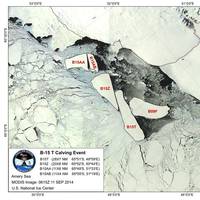
The United States National Ice Center (NIC) named three new icebergs after a previous iceberg B15T broke into four pieces. B15T remains, while the resultant icebergs are named B15Z, B15AA and B15AB. B15T is the largest surviving remnant of the largest ever recorded iceberg B15, which calved from the Ross Ice Shelf in March of 2000 and was roughly the size of Jamaica when it originally separated from Antarctica. As B15 broke apart, all pieces over 10 nautical miles long received their own designation and were tracked.
Coast Guard Preps for Arctic Research
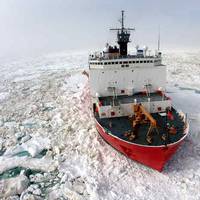
A team of scientists from the U.S. Coast Guard (USCG) Research and Development Center (RDC) will depart from Seward, Alaska, for a technology evaluation in the Arctic aboard the Coast Guard Cutter Healy Aug. 8, the Coast Guard announced. According to the USCG, the RDC is leading a multiagency team to support Arctic Shield 2014, a 17th Coast Guard District initiative. The purpose of their month-long evaluation is to improve USCG capabilities in the Arctic region, specifically in the areas of boat operations, communications, navigational safety and oil spill response.
Scientific Team Arctic-bound Aboard Cutter 'Healy'
A team of scientists from the Coast Guard Research and Development Center (RDC) is to depart shortly from Seward, Alaska, for a technology evaluation in the Arctic aboard the Cutter 'Healy informs USCG. The RDC is leading a multi-agency team to support Arctic Shield 2014, a 17th Coast Guard District initiative. The purpose of their month-long evaluation is to improve Coast Guard capabilities in the Arctic region, specifically in the areas of boat operations, communications, navigational safety and oil spill response. “The RDC plays a key role in charting the service’s future efforts in the Arctic by evaluating new and emerging technologies for applicability to Coast Guard operations in a harsh and remote environment,” said Capt. Dennis Evans, commanding officer of the RDC.
Huge Iceberg Broken off Antarctica Heads for Open Ocean
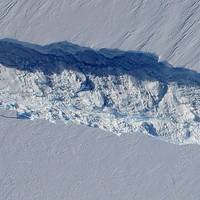
Scientists are monitoring an iceberg roughly six times the size of Manhattan - one of the largest now in existence - that broke off from an Antarctic glacier and is heading into the open ocean. NASA glaciologist Kelly Brunt said on Wednesday the iceberg covers about 255 square miles (660 square km) and is up to a third of a mile (500 meters) thick. Known as B31, the iceberg separated from Antarctica's Pine Island Glacier last November, Brunt added. "It's one that's large enough that it warrants monitoring," Brunt said in a telephone interview, noting that U.S.
Navy Updates Plans for a Changing Arctic
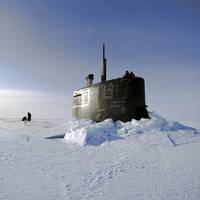
"This updated Navy Arctic Roadmap prepares the U.S. Navy to respond effectively to future contingencies, delineates the Navy's Arctic leadership role within the Defense Department, and articulates the Navy's support to achieve national priorities," writes Chief of Naval Operations (CNO) Adm. Jonathan Greenert in the Roadmap introduction. In the coming decades, as multi-year sea ice in the Arctic Ocean recedes, previously unreachable areas may open for maritime use for a few weeks each year.
U.S. Navy Responds to Increased Arctic Activity
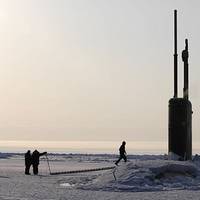
The loss of seasonal sea ice in the Arctic will have ramifications for the U.S. Navy in terms of future missions, force structure, training and investments. To get a better handle on planning for future Arctic missions, Chief of Naval Operations (CNO) Adm. Jonathan Greenert asked me to provide an unambiguous assessment of how ice coverage will change in the Arctic and how human activity in the Arctic will change in response to decreased ice coverage and other factors. To understand this challenge, let me give you a little background.
When Will New Arctic Maritime Crossroad Open?
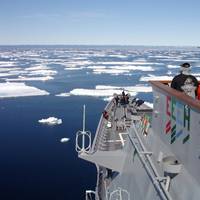
Rear Adm. Jon White, Oceanographer & Navigator of the Navy, Director Task Force Climate Change, was tasked by the Chief of Naval Operations (CNO) Adm. Jonathan Greenert to provide an unambiguous assessment of how ice coverage will change in the Arctic and how human activity in the Arctic will change in response to decreased ice coverage and other factors. "The loss of seasonal sea ice in the Arctic will have ramifications for the U.S. Navy in terms of future missions, force structure, training and investments. To understand this challenge, let me give you a little background.
U.S. Navy Pursues Better Weather Forecasting
Navy Researchers Seek to Improve Weather Prediction for Global Operations. With the Atlantic hurricane season officially beginning this month, the Office of Naval Research (ONR) is pursuing a number of projects to help Navy forecasters and meteorologists around the world predict storms better. ONR's efforts in funding ocean research are yielding enhanced weather and ocean prediction models-highlighted in a new video-that help Navy leaders understand how to route ships around the globe to avoid storms, reduce fuel consumption, avoid Arctic ice flows and promote safety at sea. "Weather is one of the most significant factors affecting naval operations at sea," said Chief of Naval Research Rear Adm. Matthew Klunder.
Arctic Surveys Yielding Data and Savings
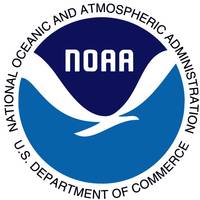
U.S.-Canada Arctic Ocean survey partnership saved costs, increased data; 2011 mission concludes joint seafloor survey operations. A recent mission marked the completion of a five-year collaboration between the United States and Canada to survey the Arctic Ocean. The bilateral project collected scientific data to delineate the continental shelf beyond 200 nautical miles from the coastline, also known as the extended continental shelf (ECS). The U.S. has an inherent interest in knowing…
NOAA Buoys Deployed in the Arctic
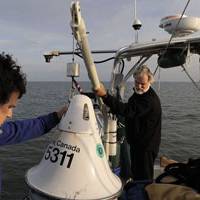
Now traversing the Northwest Passage, the Ocean Watch crew - four professional sailors, a scientist and an educator - recently completed the deployment of three NOAA Global Drifter Program buoys. Dr. Ignatius Rigor, research scientist at the University of Washington Applied Physics Laboratory (UW-APL) Polar Science Center and Coordinator of the International Arctic Buoy Program (IABP) is directing these activities. This project, one of 8 scientific projects planned throughout the 13-month Around the Americas expedition…
Navy Charts Way Ahead in Arctic
The chief of naval operations created a task force, headed by the Navy's senior oceanographer, to better understand and evaluate the changing climate and its implications for maritime security. "Task Force Climate Change was initiated ... to assess the Navy's preparedness to respond to emerging requirements and to develop a science-based time line for future Navy actions regarding climate change," explained Rear Adm. "Because the Arctic is changing faster than any other place on the planet, our first deliverable will be a strategic roadmap proposing actions for the Navy regarding the Arctic region," Titley said. This may include an assessment of how the maritime strategy applies to the Arctic region…
Kruse, Director National/Naval Ice Center
Commander Denise Kruse will relieve Captain Raymond Chartier as Director of the National Ice Center (NIC), Commanding Officer of the Naval Ice Center (NAVICECEN), and CO-Director of the North American Ice Service (NAIS), Suitland, MD at a ceremony to be held at the U.S. Navy Memorial Heritage Center in Washington, DC on December 16, 2008. Captain Chartier has been Director/Commanding Officer since May 23, 2007. Commander Kruse’s previous assignment was US Naval Central Command /Combined Maritime Force/Fifth Fleet Staff Oceanographer. NIC is a multi-agency operational center operated jointly by the U.S. Navy (through NAVICECEN), the National Oceanic and Atmospheric Administration, and the U.S. Coast Guard.
Navy, NOAA, USCG Sign Memorandum of Understanding
By Lt. j.g. Top officials from the U.S. Navy, the National Oceanic and Atmospheric Administration (NOAA) and the U.S. Coast Guard signed a Memorandum of Understanding July 21, reaffirming their support of the National Ice Center (NIC). The NIC, an interagency office jointly operated by the Navy (Naval Ice Center), NOAA and Coast Guard, provides strategic and tactical ice analyses and other services that aid the navigation of U.S. vessels in ice-infested waters. “Today’s update to our original working agreement, first signed in 1995, means that the National Ice Center can continue monitoring the waterways for potentially dangerous ice and help guide ships out of harm’s way for the safe, efficient delivery of goods,” said retired Vice Adm. Conrad C.
National/Naval Ice Center Celebrates 30 Years of Interagency Cooperation
In a new era of increased interagency cooperation, the National/Naval Ice Center (NIC), in Suitland, Md., is celebrating a partnership that has been working successfully for over 30 years. The NIC, comprised of the U.S. Navy, the National Oceanic and Atmospheric Administration (NOAA) and the U.S. Coast Guard (USCG), provides specialized strategic and tactical ice analyses to meet the operational needs of the U.S. government. It is the only ice center in the world that monitors sea ice in both northern and southern hemispheres by producing routine analyses of the Arctic, Antarctic and other ice infested waters. On Feb. 22, past and present staff members and leaders from the three participating agencies will gather to celebrate this unique collaboration.
Iceberg Poses Threat To Mariners In Southern Ocean
A large iceberg has entered shipping lanes between the Antarctic Peninsula and South America. The iceberg, named B-10A, measures 24 by 48 statute miles and could pose a hazard for mariners operating in the Southern Ocean, the National Ice Center reported. B-10A is presently located in the vicinity of Latitude 58 degrees, 36 minutes South, Longitude 57 degrees West, and is drifting southeast at approximately 7 to 9 miles per day. Smaller icebergs are breaking off B-10A as it moves into relatively warmer water. A cautionary zone has been established 165 miles in radius around the center point of B-10A. B-10, the “parent” iceberg from which B-10A formed, was once a piece of the Thwaites Ice Tongue, an extension of the Thwaites Glacier.







